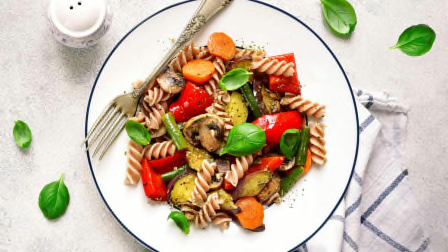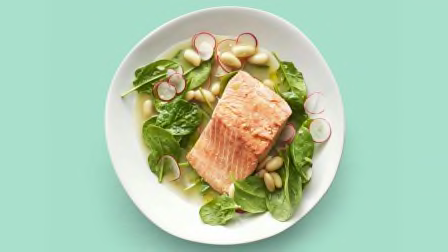Cut Back on Inflammatory Foods to Protect Your Heart and Brain
A new study shows eating to fight inflammation may lower heart disease and stroke risk

The foods we eat don’t just have an impact on our health because they affect weight, cholesterol levels, and blood pressure. Certain foods can also promote or suppress chronic inflammation—which researchers are increasingly recognizing as an underlying cause of many health problems.
While research has shown that certain types of diets (such as the Mediterranean diet) or nutrients (such as antioxidants) are associated with lower levels of inflammation, a new study published today in the Journal of the American College of Cardiology adds new evidence to the connection between inflammation and what we eat, and the risk of cardiovascular disease.
Researchers followed more than 200,000 men and women for up to 32 years. Those who had the most pro-inflammatory diets had a 46 percent increased risk of heart disease and a 28 percent increased risk of stroke compared with those who had the most anti-inflammatory diets.
What Is Inflammation
Inflammation is the immune system’s response to an illness or injury. When you have an infection or cut your finger, white blood cells produce chemicals to combat the invader or protect the area. These are released into the bloodstream, increasing blood flow to the area, causing inflammation. In cases like these, inflammation is temporary and promotes healing.
But sometimes the immune system doesn’t switch off, and it can even mistakenly treat healthy cells as a perceived threat. This can lead to low-level chronic inflammation that over time can damage healthy tissues.
How Diet Affects Inflammation
Some foods contain compounds, such as antioxidants and other phytochemicals, that dampen inflammation. Others contain substances, such as refined sugars and saturated fat, that trigger responses in the body that promote inflammation, including high blood sugar or buildup of plaque in the coronary arteries.
In the new study, researchers compared the participants’ intakes of 18 food groups known to have an effect on inflammation and the risks of heart disease and stroke. Inflammatory foods included red and processed meat; refined carbohydrates, such as white flour and sugars; and sugary beverages. Foods with the greatest anti-inflammatory properties were yellow vegetables, leafy greens, whole grains, fruits, tea, coffee, and wine.
Another study published in the same journal evaluated the effect of eating approximately 1 to 2 ounces of walnuts a day on inflammation, finding that regular walnut consumption was protective. That study was funded in part by the California Walnut Commission. But it was “the largest and longest nut trial to date,” according to an editorial accompanying the studies, providing significant evidence that including walnuts in the diet may help reduce inflammation.
In addition to nuts, the editorial’s authors also point to extra-virgin olive oil and fatty fish as anti-inflammatory.
Although the lowest risk for cardiovascular disease in Li’s study occurred in people whose diets could be considered the most anti-inflammatory, the data showed that following even a moderately anti-inflammatory diet was beneficial.
“We were surprised by the robustness of our results,” Li says. Nor did the people who ate the most “anti-inflammatory diet” completely avoid inflammatory foods, like processed meat or sugary drinks; they just consumed far less of them.
Still, this is an observational study, so the results don’t prove pro-inflammatory diets cause cardiovascular disease, even if there’s a plausible reason to think that could be the case.
While the researchers controlled for many factors that could affect inflammation status—such as smoking, weight, aspirin use, high blood pressure, and family history of cardiovascular disease—there could still be unknown characteristics that explain the differences in the results.
In addition, the majority of the study participants were white. Li and her colleagues are conducting similar research on groups that have more Black and Latino people, she says, but they expect similar results. Her advice for everyone: “Consuming more anti-inflammatory food and less pro-inflammatory food may help manage inflammation and the risk of developing cardiovascular disease.”
How to Eat an Anti-inflammatory Diet
“This research gets us closer to understanding the mechanisms that various foods can have on inflammatory markers,” says Amy Keating, RD, a nutritionist at Consumer Reports, and it stresses the importance of variety. “In general, people don’t eat enough vegetables and whole grains, and when they do, they tend to stick to the same ones. This study shows the benefit of branching out.” Here are some suggestions from Keating and other CR nutrition experts for increasing your intake of the anti-inflammatory foods highlighted in the study.
- A head of cabbage has a long shelf life in the refrigerator. You can shred it and add to your salads or toss shredded cabbage with olive oil and fresh dill for a tasty slaw.
- Raw kale can be used in a salad. Chop it finely and toss with dried fruit and chopped walnuts. Or add it into a smoothie with pineapple.
- Stuff orange or yellow bell peppers with cooked quinoa and chopped vegetables. Sprinkle with a little cheese and bake.
- Roast cubed sweet potatoes or sliced carrots with a drizzle of olive oil. Season with thyme and a bit of honey.
- Use corn tortillas to make an enchilada casserole with lean ground beef, chilis, black beans, and corn.
- Make a butternut squash polenta with sage.
- Try teff, an Ethiopian whole grain with a light, sweet flavor, in place of rice or bulgur in recipes.
- Use buckwheat soba noodles with bok choy and shrimp or chicken in a soup.
- Make a pesto with walnuts, basil or parsley, olive oil, garlic, and Parmesan cheese. Toss into whole grains or pasta or use as a topping for poultry.




















